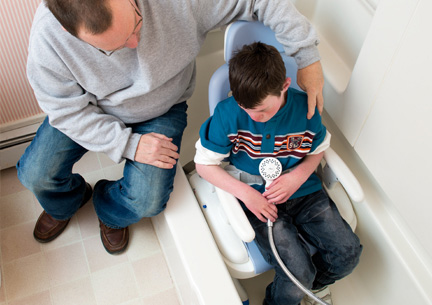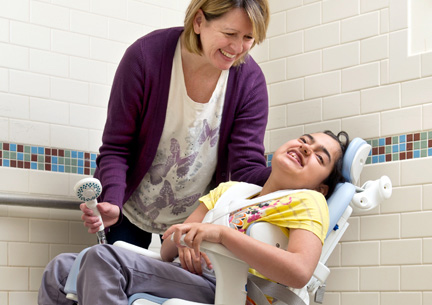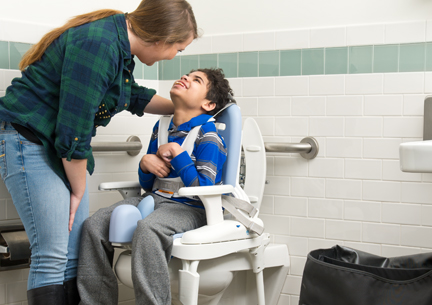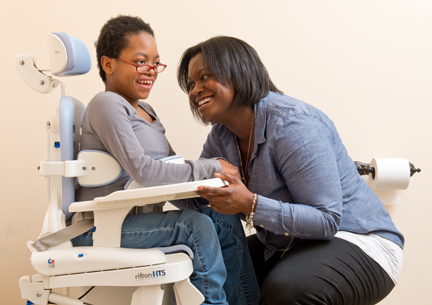Six Features To Love About the Support Station
| December 2017 When we’re talking about activities of daily living, it doesn’t get more basic—and more personal—than toileting. But the process of toileting is also a valuable opportunity to teach transfer, standing and hygiene skills—all essential to building independence in self-care.
When we’re talking about activities of daily living, it doesn’t get more basic—and more personal—than toileting. But the process of toileting is also a valuable opportunity to teach transfer, standing and hygiene skills—all essential to building independence in self-care.
A successful and thoroughly dignified approach to incorporating these skills into the toileting routine is the vertical toileting method. With this approach, instead of being passively transferred to a horizontal surface for diapering, the individual transfers to a standing position for clothing adjustment before shifting onto the toilet, and from there transfers back to standing for clothing re-adjustment and then to the wheelchair. This adds up to four sit-to-stand practice opportunities in just one toileting episode. Accessorizing the bathroom with hoists  and changing tables gets the toileting job done, but achieving independence in ADLs through teaching the sit-to-stand and weight-bearing skills as they naturally occur in a toileting routine is a far better approach.
and changing tables gets the toileting job done, but achieving independence in ADLs through teaching the sit-to-stand and weight-bearing skills as they naturally occur in a toileting routine is a far better approach.
The Support Station, a piece of adaptive equipment inspired by the MOVE Curriculum, an activity-based program, facilitates independent sit-to-stand transfers and gradual weight-bearing abilities of the client during the toileting process. Here are six ways the Support Station brings new dignity, convenience and quality-of-life improvements to people with disabilities:
1. Sit-to-Stand Transfers
Complete with a padded trunk board, kneeboard and an array of handholds, even an individual with minimal to no weight-bearing capabilities can participate in a transfer and maintain an upright position on the trunk board for clothing adjustment. In the upright position, clothing is readily accessible.
2. Early Motor Learning Opportunities
The height-adjustable trunk board makes it easy for an individual to begin toileting skills at a young age and continue this routine into adulthood. This allows ample time for motor learning to take place with the ongoing repetition and practice of skills. Over time, transfers become smoother and weight-bearing improves.
3. Improved Safety for Caregivers
The vertical toileting method eliminates transfers to a mat or changing table. This means less caregiver strain from lifting and struggling with clothing. And better overall accessibility makes the process healthier for everyone.
4. Progressive weight-bearing and stepping
The trunk board on the Support Station has angle adjustment. Gradually increasing the angle of the trunk board encourages the individual to take more weight through the lower extremities during transfers and adds further challenge to standing skills.
The pivot on the trunk board is also a great way to progress standing and stepping. The pivot feature swivels the board 90 degrees to the right or left for transfer to a fixed toilet or chair. This allows you to work on side-stepping and balance as your client moves with the trunk board.
5. Toiletry Opportunities for Head Control and Fine Motor Skills
Standing at the Support Station is also an opportunity to introduce toiletries. Placing a mirror in front of your client with accessories for hair styling, shaving or make-up encourages head control, fine motor skills and independence in self-care.
6. Beyond Toileting
Sit-to-stand practice can happen anywhere because the Support Station is more than a toileting aid. With the Support Station, clients can self-assist the stand-pivot transfer from wheelchair to adaptive chair or support themselves in an upright position for clothing changes prior to a swim session. By using their own strength and skills to participate in their care, clients improve their weight-bearing and standing ability.




